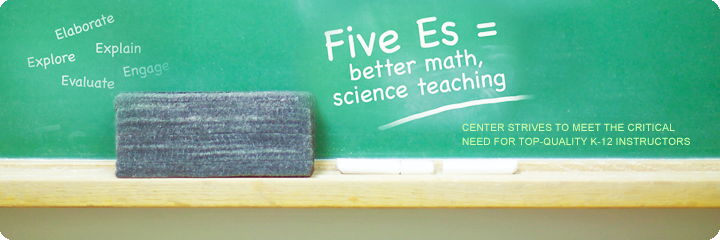
At least since Oct. 4, 1957, when the Soviet Union successfully launched Sputnik and began the space race, leaders in government, business and academia have worried over the performance of U.S. students in math and science — and over how the nation’s standing in the world would be affected by it.
Today, that concern is as urgent as ever, and Binghamton University is stepping to the forefront of efforts to improve science and math instruction in U.S. schools, said Thomas O’Brien, associate professor in the School of Education and director of Binghamton’s Center for Science, Math and Technology Education (CSMTE).
In 2006, the National Science Board reported that U.S. students were at or near the bottom among the 29 member nations of the Organization for Economic Co-operation and Development that took part in a study of how well 15-year-olds use math and science knowledge.
In an effort to explain and help reverse such a poor showing, the NSB, which is the governing body of the National Science Foundation, took a close look at the ranks of U.S. science and math teachers.
“The number of certified science and math teachers at the
middle school and high school levels is down, science education
for pre-service teachers at our nation’s education schools
appears to be less rigorous compared to other subjects, and elementary
teachers do not feel qualified teaching science,” the board
concluded.
O’Brien agrees. “There’s a need for updating a
lot of teachers who are in the field,” not only in terms of
recent scientific developments, but also in “pedagogical content
knowledge, the intersection between pedagogy with the particular
discipline,” he said.
Although they have mastered their subject areas and care deeply about their students, many public-school teachers face a challenge in teaching science and math because their training isn’t informed by the latest research, O’Brien added.
 Binghamton’s CSMTE, an organized research center, brings
faculty and graduate students from Binghamton’s School of
Education, Harpur College of Arts and Sciences and Watson School
of Engineering and Applied Science together with practicing teachers
for professional development programs. The aim is to raise the level
of math and science education and enhance the use of technology
in public-school classrooms.
Binghamton’s CSMTE, an organized research center, brings
faculty and graduate students from Binghamton’s School of
Education, Harpur College of Arts and Sciences and Watson School
of Engineering and Applied Science together with practicing teachers
for professional development programs. The aim is to raise the level
of math and science education and enhance the use of technology
in public-school classrooms.
CSMTE’s science programs expose teachers to a concept called
the Five E Cycle — “Engage, Explore, Explain, Elaborate,
Evaluate,” O’Brien said.
Relying only on “Engage” — enlivening lessons
with hands-on activities — isn’t the way to make sure
students absorb new concepts, he said.
The most effective format for instruction is instead the integrated content unit, “a sequence of linked activities, some of which could be book learning, some of which could be a hands-on lab, some of which could be a computer simulation,” followed by an assessment, he added.
Teaching math and science is especially challenging for many instructors in kindergarten through seventh grade. Unlike their colleagues in eighth grade and high school, these teachers aren’t required to specialize in a content area, said C. Beth Burch, a professor in the School of Education. They may have taken one ortwo mathematics courses in their entire college careers, she said.
page 1 | page 2